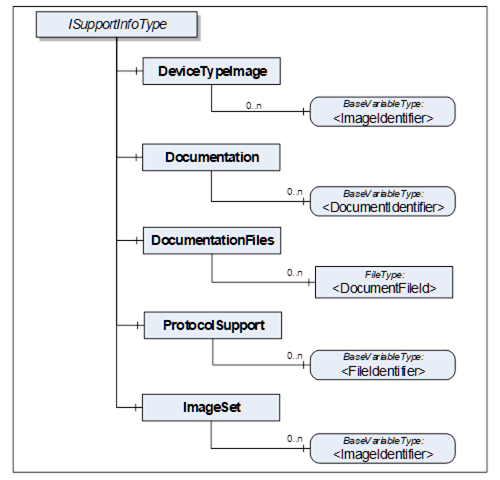The SupportInfo Interface defines a number of additional data that a commonly exposed for Devices and their components. These include mainly images, documents, or protocol-specific data. The various types of information are organized into different folders. Each information element is represented by a read-only Variable. The information can be retrieved by reading the Variable value.

Figure 8 Illustrates the SupportInfo Interface. It is formally defined in Table 27.

Figure 8 – Support information Interface
Table 27 – ISupportInfoType definition
|
Attribute |
Value |
||||
|
BrowseName |
1:ISupportInfoType |
||||
|
IsAbstract |
True |
||||
|
References |
NodeClass |
BrowseName |
DataType |
TypeDefinition |
Other |
|
Subtype of the BaseInterfaceType defined in OPC 10000-5 |
|||||
|
|
|
|
|
||
|
0:HasComponent |
Object |
1:DeviceTypeImage |
|
0:FolderType |
O |
|
0:HasComponent |
Object |
1:Documentation |
|
0:FolderType |
O |
|
0:HasComponent |
Object |
1:DocumentationFiles |
|
0:FolderType |
O |
|
0:HasComponent |
Object |
1:ProtocolSupport |
|
0:FolderType |
O |
|
0:HasComponent |
Object |
1:ImageSet |
|
0:FolderType |
O |
|
Conformance Units |
|||||
|
DI DeviceSupportInfo |
|||||
Clients should be aware that the contents that these Variables represent can be large. Reading large values with a single Read operation can be impossible due to configured limits in either the Client or the Server stack. The default maximum size for an array of bytes is 1 MiB. It is recommended that Clients use the IndexRange in the OPC UA Read Service (see OPC 10000-4) to read these Variables in chunks, for example, one-megabyte chunks. It is up to the Client whether it starts without an index and repeats with an IndexRange only after an error or whether it always uses an IndexRange.
The components of the ISupportInfoType have additional references as defined in Table 28.
Table 28 – 1:ISupportInfoType Additional Subcomponents
|
Source Path |
References |
NodeClass |
BrowseName |
DataType |
TypeDefinition |
Other |
|
1:DeviceTypeImage |
0:HasComponent |
Variable |
1:<ImageIdentifier> |
0:Image |
0:BaseDataVariableType |
MP |
|
1:Documentation |
0:HasComponent |
Variable |
1:<DocumentIdentifier> |
0:ByteString |
0:BaseDataVariableType |
MP |
|
1:DocumentationFiles |
0:HasComponent |
Object |
1:<DocumentFileId> |
|
0:FileType |
MP |
|
1:ProtocolSupport |
0:HasComponent |
Variable |
1:<ProtocolSupportIdentifier> |
0:ByteString |
0:BaseDataVariableType |
MP |
|
1:ImageSet |
0:HasComponent |
Variable |
1:<ImageIdentifier> |
0:Image |
0:BaseDataVariableType |
MP |
Pictures can be exposed as Variables organized in the DeviceTypeImage folder. There can be multiple images of different resolutions. Each image is a separate Variable.
All images are transferred as a ByteString. The DataType of the Variable specifies the image format. OPC UA defines BMP, GIF, JPG and PNG (see OPC 10000-3).
Documents in many cases will represent a product manual. They can be exposed as Variables or as FileType instances. Files are useful in particular for large documents.
- Documents as Variables are represented as a ByteString and organized in the Documentation folder. The BrowseName of each Node will consist of the filename including the extension that can be used to identify the document type. Typical extensions are “.pdf” or “.txt”.
- Documents as FileType instances are organized in the DocumentationFiles folder. They are retrieved from the Server by using the FileType Methods. It is recommended to use the MimeType Property to specify the media type of the file based on RFC 2046.
Protocol support files are exposed as Variables organized in the ProtocolSupport folder. They can represent various types of information as defined by a protocol. For example a GSD file.
All protocol support files are transferred as a ByteString. The BrowseName of each Variable shall consist of the complete filename including the extension that can be used to identify the type of information.
Images that are used within UIElements are exposed as separate Variables rather than embedding them in the element. All image Variables will be aggregated by the ImageSet folder. The UIElement shall specify an image by its name that is also the BrowseName of the image Variable. Clients can cache images so they don't have to be transferred more than once.
The DataType of the Variable specifies the image format. OPC UA defines BMP, GIF, JPG and PNG (see OPC 10000-3).